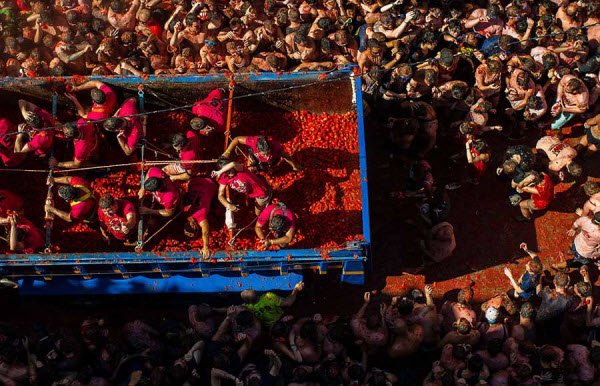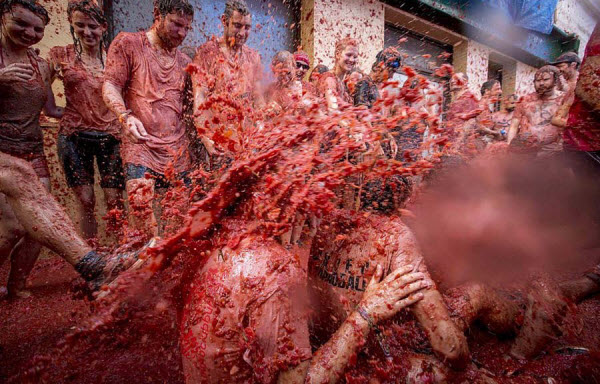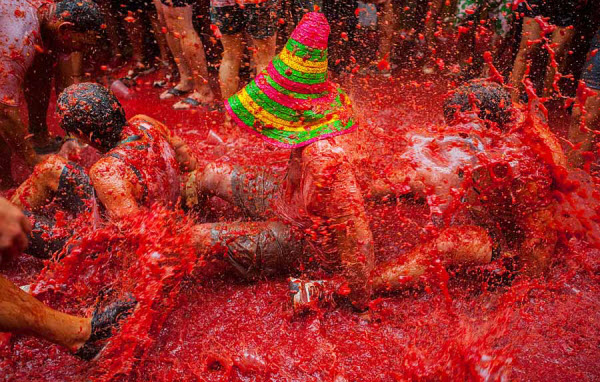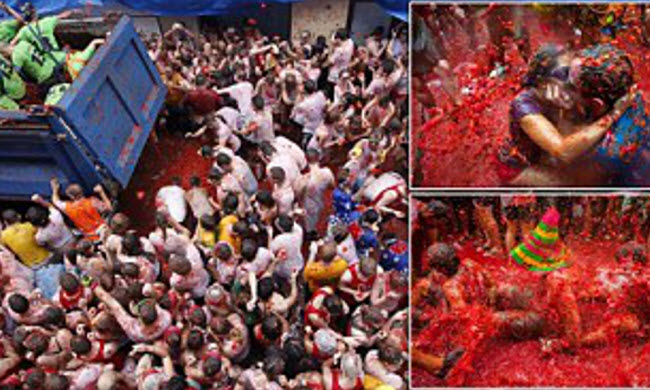When conflicts arise between parties, they often resort to using weapons to exchange fire in hopes of winning the fight. However, some countries, like Spain, have decided to put aside their weapons and instead engage in a battle using tomatoes. This vibrant and unconventional tradition is known as the Tomatina Festival, or “La Tomatina,” which takes place in the town of Buñol in Valencia. Tens of thousands of people from both within Spain and abroad gather to celebrate this peculiar festival, where nearly 150 tons of tomatoes are thrown at one another, commemorating a historic event while enjoying themselves and having fun.
The origins of La Tomatina trace back to the last Wednesday of August in 1945. A group of young people in Buñol attended a parade featuring individuals dressed in giant masks of prominent figures. These young people decided to join in by harassing the musicians and mask-wearers. One mask-wearer fell and, enraged, began hitting everything in his path. This led to a spontaneous food fight involving tomatoes from a nearby vegetable stand. The authorities eventually intervened to stop the melee. The following year, the young people organized a premeditated tomato fight, bringing their own tomatoes from home. Although the police intervened, this event set the stage for future celebrations. In the early 1950s, General Francisco Franco banned La Tomatina due to its lack of religious significance. However, locals protested, and the festival was reinstated. A significant demonstration took place in 1957, where residents carried a giant tomato in a mock funeral procession. This protest successfully led to the festival being allowed again, and it has grown in participation and popularity over the years. By 2013, due to the large number of participants, the authorities restricted entry to ticket holders, capping attendance at 20,000 people.


La Tomatina is held in Buñol, a small town located 38 kilometers west of Valencia, Spain, on the banks of the Buñol River. Surrounded by various mountain ranges, Buñol covers an area of 112 square kilometers and has a predominantly agricultural economy with a small industrial base. The town, with a population of 9,000, remains quiet throughout the year except during the last Wednesday of August when it attracts thousands of visitors from across Spain and other countries. The festival’s global fame has led to a surge in participants, from a few thousand at its inception to 50,000 in 2012. The town’s capacity to handle such large numbers became strained, leading to a ticketing system to control attendance.


To prepare for La Tomatina, participants wear clothes they don’t mind getting rid of. Some opt for white shirts to highlight the red color of the tomatoes, while others wear swimsuits underneath for easier cleanup. It’s advisable to wear old sports shoes and bring swimming goggles to protect eyes from tomato acid. Anything valuable should be left in a safe place outside the festival area to avoid damage. Those planning to take photos should use waterproof cameras.


The festival begins around 11 a.m. when 150 tons of tomatoes are scattered across various locations. The following hour is spent mashing and throwing tomatoes at each other. When the hour ends, a firework signals the end of the tomato fight. While adults enjoy the main event, children can participate in a scaled-down version held on the Saturday before the main festival. This children’s event uses smaller tomatoes and takes place in a fenced-off area on the main street.


The tomato fight typically lasts about an hour. The town council issues safety instructions for participants, including not throwing anything other than tomatoes, avoiding tearing clothes, and ensuring tomatoes are squashed before throwing to prevent injury. Participants should maintain a safe distance from tomato-throwing trucks and follow security guidelines. After the festival, plastic covers are used to protect store fronts, and fire trucks equipped with hoses clean the streets. Participants often use hoses provided by locals or go to the “Los Peñones” pool for a wash. Fortunately, the citric acid in tomatoes helps to clean the city surfaces effectively.


Due to the festival’s popularity, similar events have been organized worldwide. Since 2004, the Colombian city of Sutamarchán has hosted an annual tomato event on June 15, using surplus tomatoes from the harvest. In Dongguan, southern China, a tomato fight occurs on October 19. In Karnataka, India, a similar festival was planned but banned due to concerns over tomato wastage.
